Trademark Class 22: How to Protect Your Sacks, Bags, and Packaging Brand Legally
In today’s competitive business world, brands in the sacks, bags, and packaging industry face constant challenges from competitors and counterfeiters. Whether you manufacture jute sacks, industrial bags, ropes, nets, or packaging materials, your brand identity is one of your most valuable assets. Protecting it through trademark registration under Class 22 not only safeguards your brand but also builds trust and recognition in the market.
This blog will explain everything you need to know about trademark protection for sacks, bags, and packaging under Class 22, including covered products, the registration process, benefits, and common mistakes to avoid.

🌐 What Is Trademark Class 22?
Trademark Class 22 is one of the 45 classes under the Nice Classification (NCL) system, which is used worldwide to categorize goods and services for trademark registration.
Class 22 specifically includes products made from natural or synthetic fibers that are not yet turned into fabrics. It covers a wide range of raw materials and related items such as:
- Ropes and cords
- Nets and tents
- Sacks and bags (including large industrial bags, jute bags, and mesh sacks)
- Packaging materials made from textile fibers
- Tarpaulins, awnings, and sails
- Hammocks, straps, and strings
If your business is involved in manufacturing or selling sacks, packaging bags, or related products, then Class 22 is the correct trademark class to register your brand under.
🛍️ Why Trademark Matters for Sacks, Bags, and Packaging Brands
The sacks and packaging industry is huge, serving multiple sectors like agriculture, construction, retail, logistics, and FMCG. However, with such a wide market comes intense competition and risk of brand misuse.
Here’s why trademark registration is crucial for your sacks, bags, and packaging brand:
- Exclusive Rights – Protects your brand name, logo, or tagline from being copied by competitors.
- Customer Trust – Helps customers identify your products in the market, ensuring authenticity.
- Legal Protection – Enables you to take legal action against counterfeit or look-alike products.
- Competitive Edge – Gives you a unique identity in a crowded marketplace.
- Business Expansion – Helps secure licensing or franchise opportunities when scaling your brand.
Without a registered trademark, your sacks or packaging brand is vulnerable to infringement, fake products, and loss of credibility.
📦 Products Covered Under Class 22 (Relevant to Sacks, Bags, and Packaging)
If your business deals with bags and packaging products, the following items fall under Trademark Class 22:
- Sacks and Bags
- Jute sacks
- Gunny bags
- Mesh bags
- Large industrial bags
- Net bags for packaging
- Packaging Materials
- Textile-based packaging material
- Flexible fiber packaging
- Cord and rope-based packaging
- Related Items
- Tarpaulins
- Nets for storage or transport
- Hammocks and awnings
- Strings, straps, and ropes
👉 Remember: Plastic packaging materials generally fall under Class 17, and paper-based packaging is covered under Class 16. But textile, jute, or fiber-based sacks and bags are protected under Class 22.
📝 How to Trademark Your Sacks, Bags, and Packaging Brand Under Class 22
Registering a trademark may seem complex, but if you follow a systematic approach, it becomes much easier. Here’s a step-by-step guide for protecting your brand under Class 22:
1. Trademark Search
Before filing, conduct a trademark availability search on the IP India public search portal. This ensures your brand name/logo is not already registered by another business.
2. Choose the Right Trademark Class
Since your products are sacks, bags, or packaging made from textile or fiber, select Class 22. Choosing the wrong class may result in rejection.
3. Prepare the Application
You’ll need:
- Brand name/logo
- Details of goods covered (e.g., sacks, jute bags, packaging material)
- Applicant details (individual, company, partnership, etc.)
4. File the Trademark Application
You can file online via the IP India website or through a trademark attorney. A unique application number will be generated.
5. Examination Stage
The Trademark Office reviews your application. If there are objections, you’ll receive an Examination Report, which must be replied to carefully.
6. Publication in Journal
If accepted, your trademark is published in the Trademark Journal for 4 months, allowing the public to raise objections.
7. Trademark Registration
If no opposition arises, your trademark is registered, and you’ll receive a Trademark Registration Certificate.
✅ Benefits of Registering Your Trademark Under Class 22
When you register your sacks, bags, or packaging brand under Class 22, you enjoy several advantages:
- Legal Ownership – Nobody else can use your registered brand name/logo.
- Brand Recognition – Customers easily recognize and trust your brand.
- Infringement Protection – You can take legal action against counterfeiters.
- Business Growth – Trademarks help you expand nationally and internationally.
- Valuable Asset – Over time, your trademark itself becomes a business asset that can be sold, licensed, or franchised.
⚠️ Common Mistakes to Avoid While Filing Trademark in Class 22
Many businesses lose protection due to avoidable errors. Here’s what you should avoid:
- Wrong Trademark Class – Filing under Class 16 or 17 instead of 22.
- Generic Names – Using common terms like “Super Bags” or “Best Packaging,” which are not distinctive.
- Skipping Trademark Search – Filing without checking availability, leading to rejection.
- Not Covering All Goods – Failing to specify all relevant products (sacks, nets, bags, packaging).
- Delaying Renewal – Forgetting to renew your trademark every 10 years.
🌍 Example: Why Class 22 Trademark Matters
Imagine you own a company that manufactures eco-friendly jute bags for shopping and packaging. Your brand name is “GreenSack.” Without a trademark:
- A competitor may launch “GreenSacks” with similar packaging.
- Customers may get confused and buy from them instead.
- You may lose your brand reputation and sales.
With a registered trademark:
- You have exclusive rights to the brand “GreenSack.”
- You can sue the competitor for infringement.
- Your brand becomes more trustworthy to eco-conscious buyers.
This shows how a Class 22 trademark is essential for long-term brand protection.
🔄 Renewal of Trademark for Sacks, Bags, and Packaging
A trademark in India is valid for 10 years and must be renewed before expiry. Renewal ensures continuous protection of your brand.
- Renewal Period – Every 10 years
- Grace Period – 6 months after expiry (with late fees)
- If Not Renewed – The trademark is removed from the register, and your brand becomes vulnerable.
Always set reminders to renew your Class 22 trademark on time.
📌 Final Thoughts
For businesses in the sacks, bags, and packaging industry, protecting your brand under Trademark Class 22 is not optional — it’s essential. A strong trademark builds customer trust, legal security, and brand recognition, helping you grow in a competitive market.
By registering your trademark under Class 22, you ensure that your brand identity remains exclusively yours, giving you the legal and commercial advantage you need.
🚀 How VMK Professionals Can Help
At VMK Professionals, we specialize in trademark registration, objections, renewals, and brand protection. Our expert team ensures that your Class 22 trademark for sacks, bags, and packaging is filed correctly, legally protected, and renewed on time.
📞 Contact us today to safeguard your packaging brand and stay ahead of the competition!



